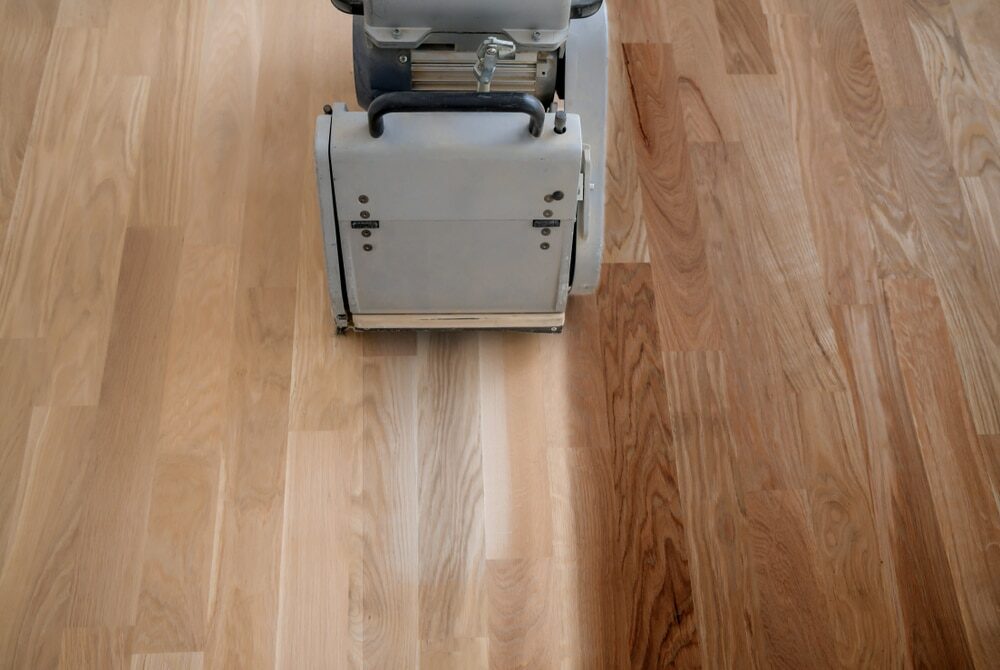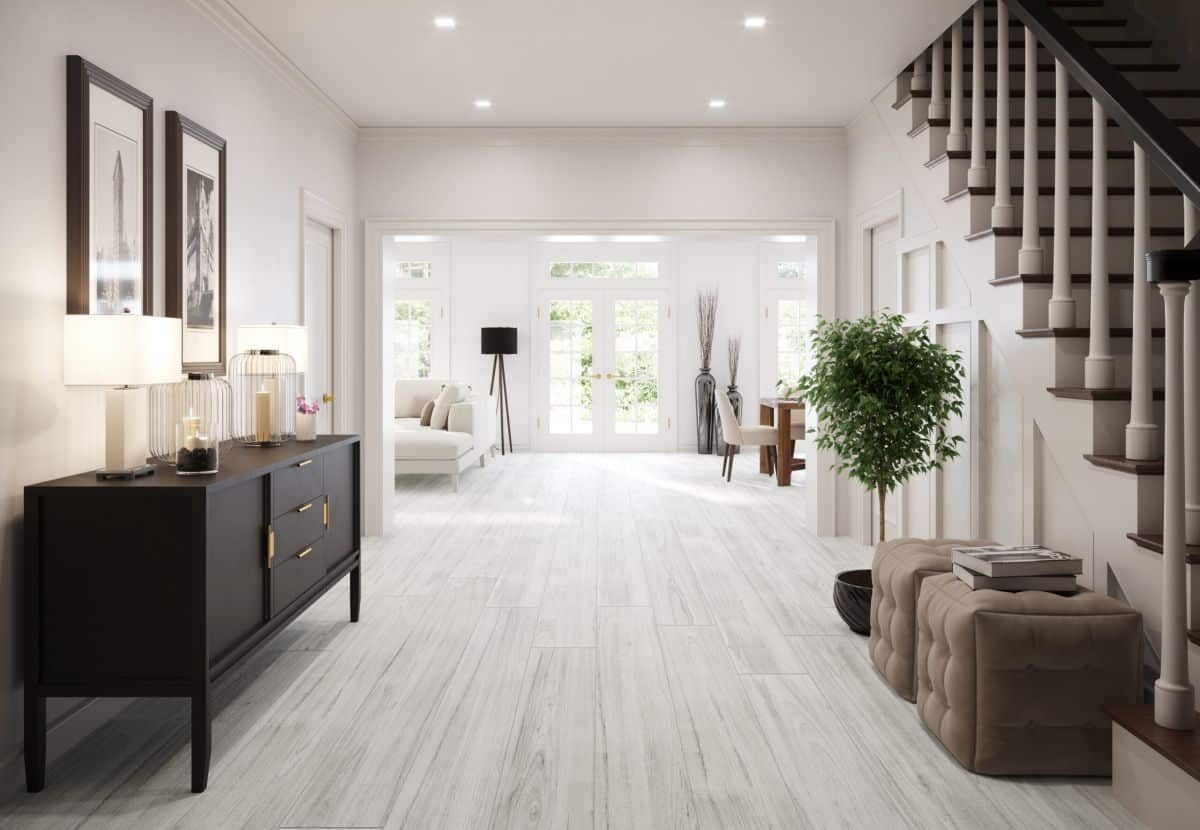London:
Nationwide:
Vinyl Flooring Types: A Comprehensive Guide to Options in the UK
Posted on December 5, 2023
Vinyl Flooring
Ultimate Guide to Vinyl Flooring in the UK: Types, Trends, and Tips
Vinyl flooring, an increasingly popular choice among homeowners and businesses in the UK. In this guide, we will delve into the world of vinyl flooring, exploring its various types, designs, and practical benefits.
Why vinyl flooring?
Vinyl flooring has gained significant traction in the UK due to its versatility, durability, and affordability. This flooring option caters to a wide range of aesthetic preferences and functional requirements, making it a suitable choice for different settings, from cosy homes to bustling commercial spaces.
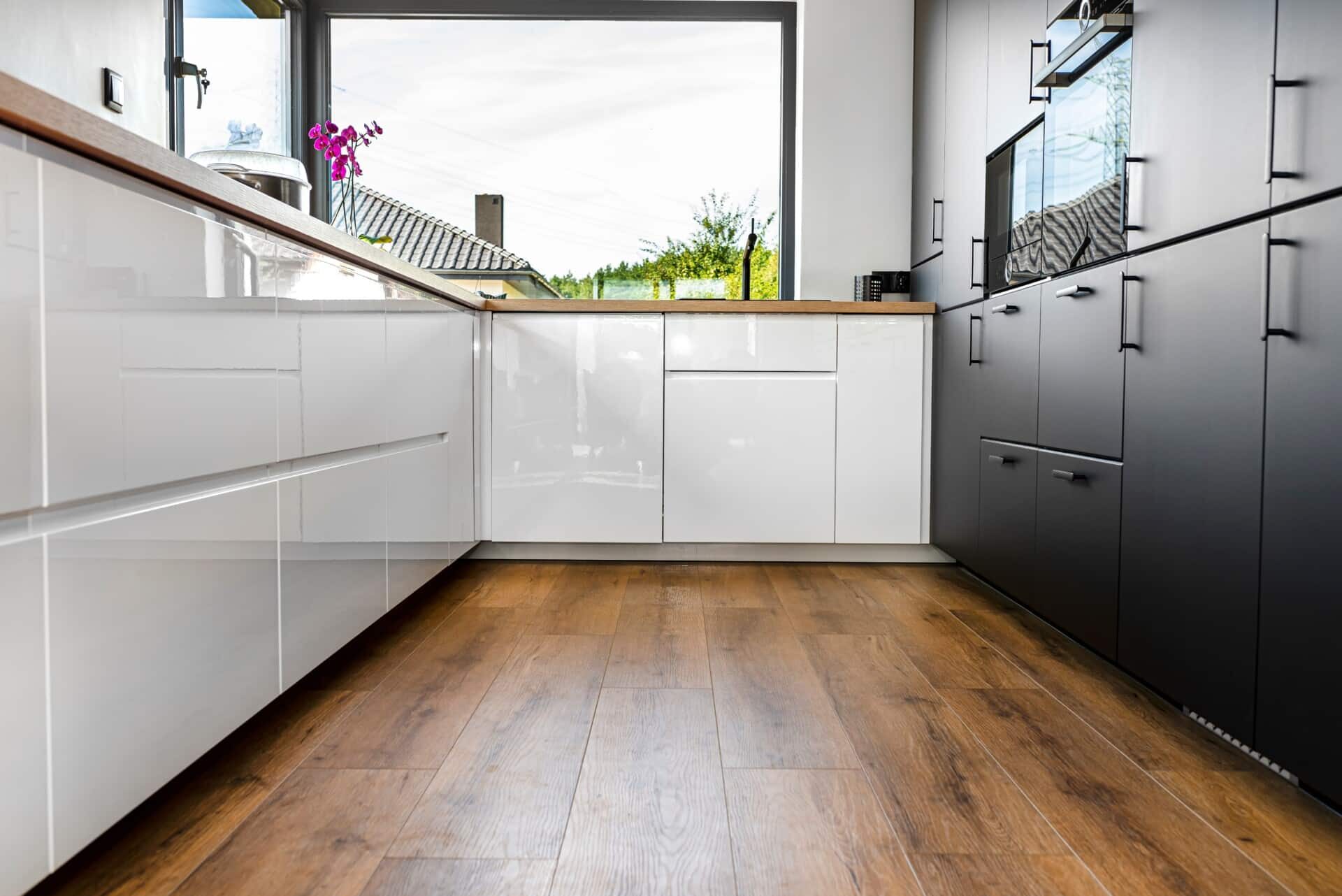
Types of vinyl flooring
In this section, we’ll explore the different types of vinyl flooring available in the UK market, each with its own unique characteristics, applications, and installation methods.
1. Sheet Vinyl Flooring
- Description: Sheet vinyl flooring comes in large, continuous, flexible sheets. It’s a single roll of vinyl, offering a seamless appearance.
- Ideal for: spaces where moisture resistance is crucial, like bathrooms and kitchens.
- Installation: Generally glued down over the subfloor.
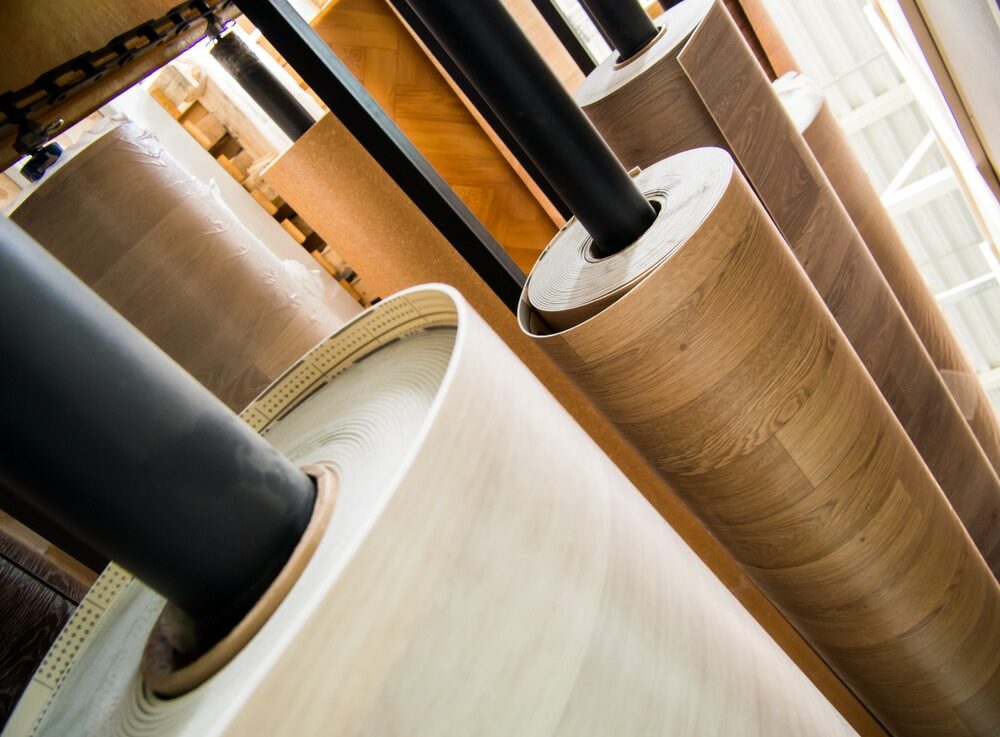
2. Vinyl Tiles
- Description: These are square-shaped tiles that mimic the look of ceramic tiles. They offer more flexibility in design and are easier to install.
- Ideal for: DIY projects and areas where you want a tiled look with the benefits of vinyl.
- Installation: Typically adhered to the floor using a special adhesive.
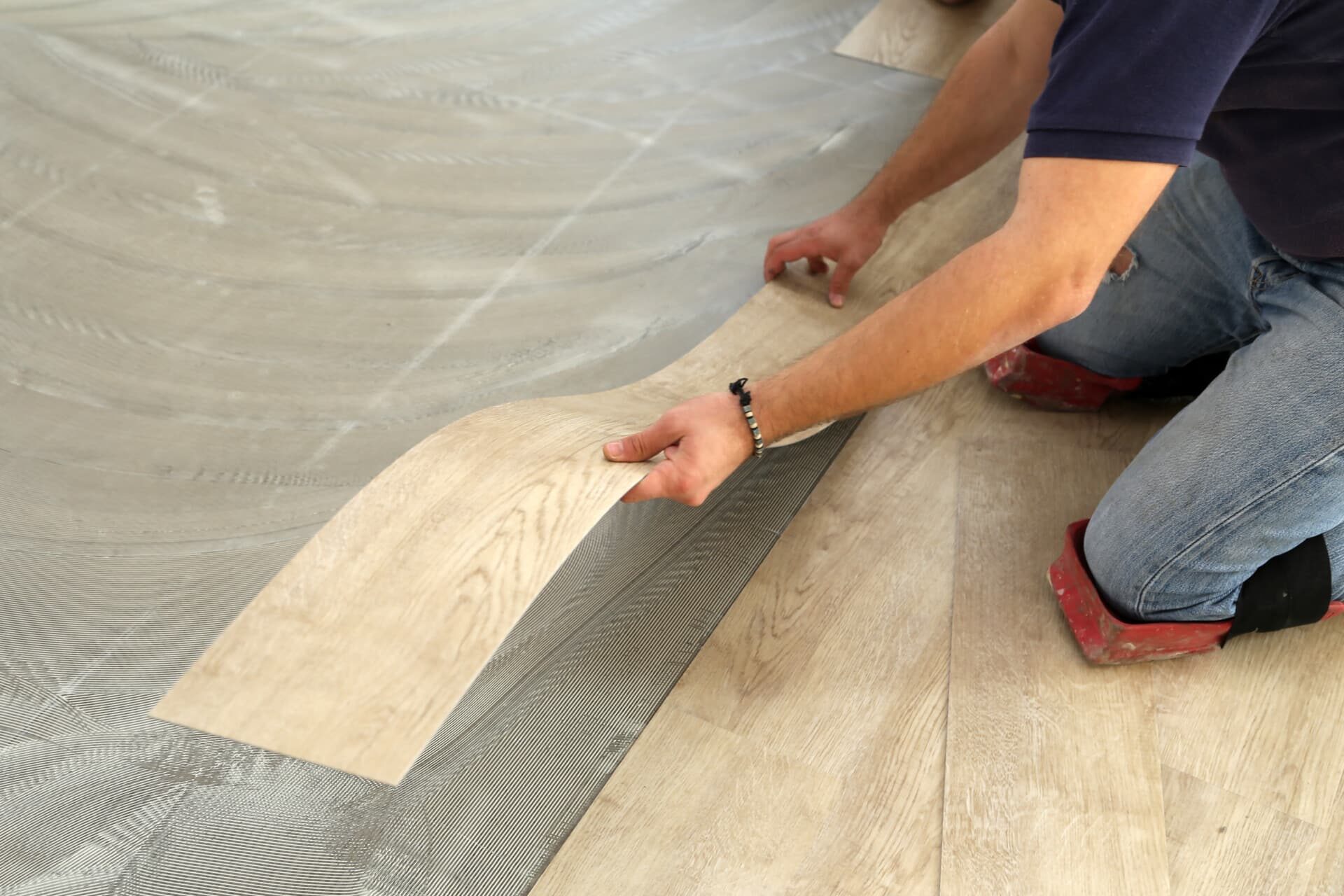
3. Luxury Vinyl Tiles (LVT)
- Description: LVT is a premium vinyl flooring option that offers realistic textures and designs, closely mimicking materials like hardwood and stone.
- Ideal for: high-traffic areas and spaces where a luxurious aesthetic is desired.
- Installation: Can be glued down or come with a click-lock system for floating installation.
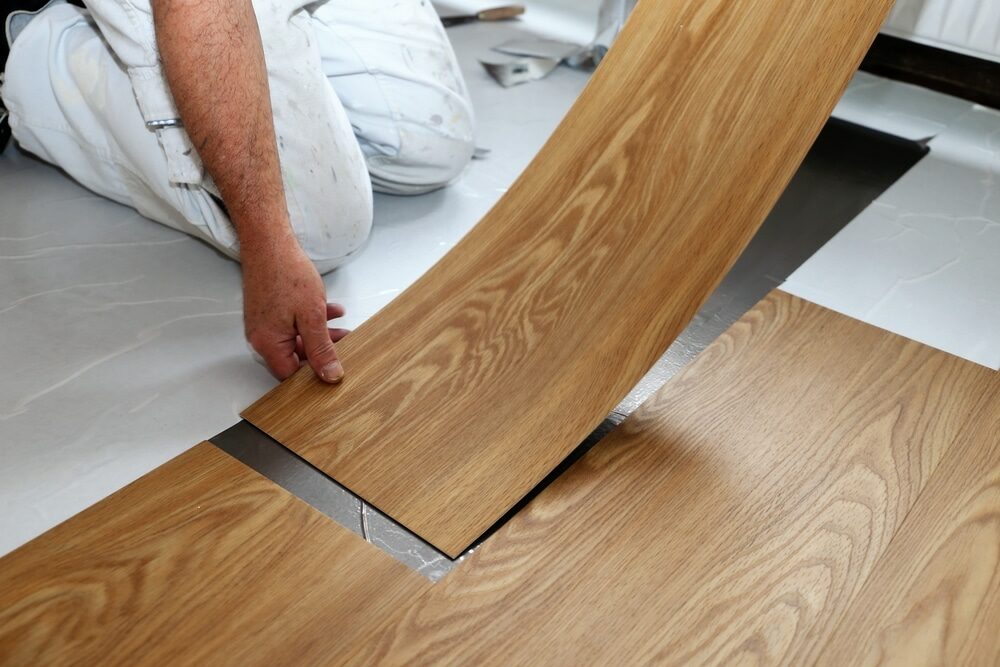
4. Vinyl Planks
- Description: Vinyl planks are long, narrow strips that replicate the look of hardwood floors. They provide the elegance of wood without the high maintenance.
- Ideal for: living rooms, bedrooms, and offices seeking a wood-like appearance.
- Installation: Often designed with a click-lock system for easy, glueless installation.
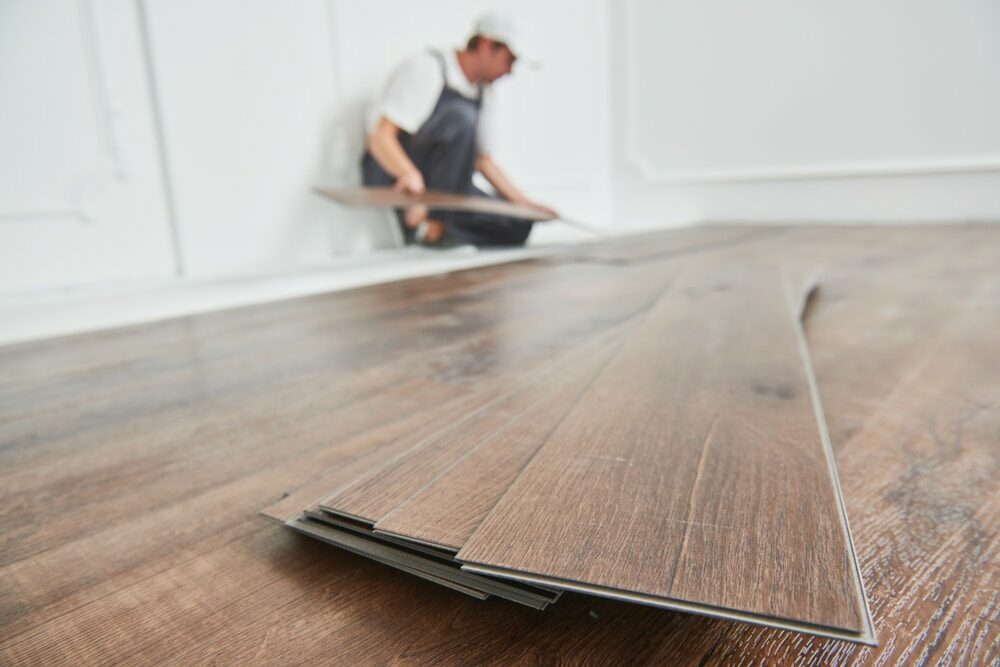
5. Woven Vinyl Flooring
- Description: This less common type incorporates a blend of vinyl and fibrous materials, creating a unique texture.
- Ideal for: spaces where a unique, tactile surface is desired.
- Installation: Similar to other vinyl types, depending on the product specifications.
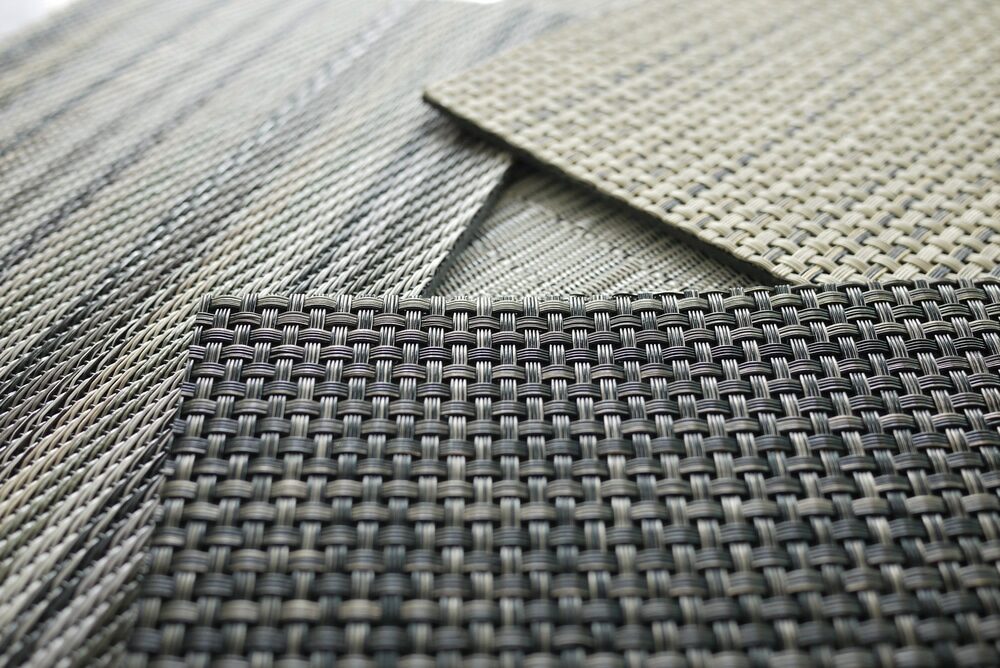
6. Printed Vinyl Flooring
- Description: This type allows for a wide range of designs and patterns, printed directly onto the vinyl.
- Ideal for: custom designs or specific aesthetic requirements.
- Installation: Varies, but often installed like traditional vinyl sheets or tiles.
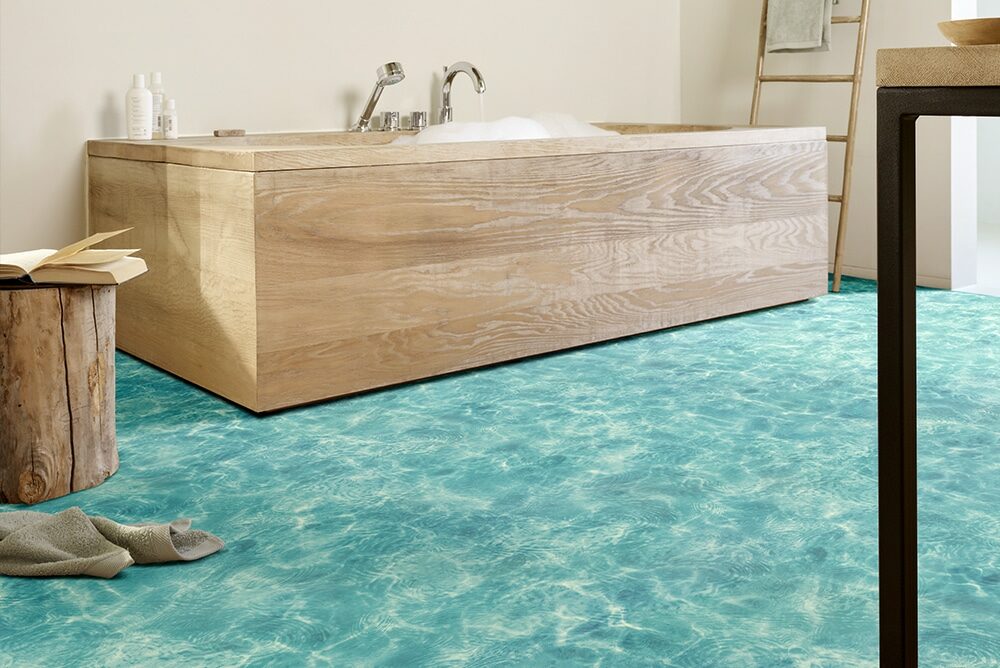
Each of these vinyl flooring types offers its own set of benefits, ranging from cost-effectiveness and durability to aesthetic diversity and ease of installation. Understanding the differences can help you choose the right vinyl flooring for your specific needs in a UK context.
Advantages and Disadvantages of Vinyl Flooring
Vinyl flooring, with its varied types and styles, offers a range of benefits and some limitations. Here, we’ll discuss the key advantages and disadvantages to consider when choosing vinyl flooring for your space in the UK.
Advantages of Vinyl Flooring
- Durability: Vinyl flooring is known for its resilience and ability to withstand heavy foot traffic, making it ideal for both residential and commercial spaces.
- Water Resistance: Most vinyl flooring types are water-resistant, and some are completely waterproof, which is perfect for bathrooms, kitchens, and basements.
- Ease of Installation: Vinyl flooring can be easier to install compared to other flooring types, with options like peel-and-stick tiles or click-and-lock planks.
- Cost-Effectiveness: Generally, vinyl flooring is more affordable than other flooring options like hardwood or stone, offering a budget-friendly alternative.
- Maintenance: Vinyl floors are low-maintenance, requiring regular sweeping and occasional mopping. They don’t need special treatments like some other floor types.
- Variety of Styles: Available in a wide range of colours, patterns, and designs, vinyl flooring can mimic the look of more expensive materials like hardwood and stone.
- Comfort Underfoot: Vinyl flooring is softer and warmer underfoot compared to hard surfaces like tile or stone, which can be a comfort advantage in living spaces.
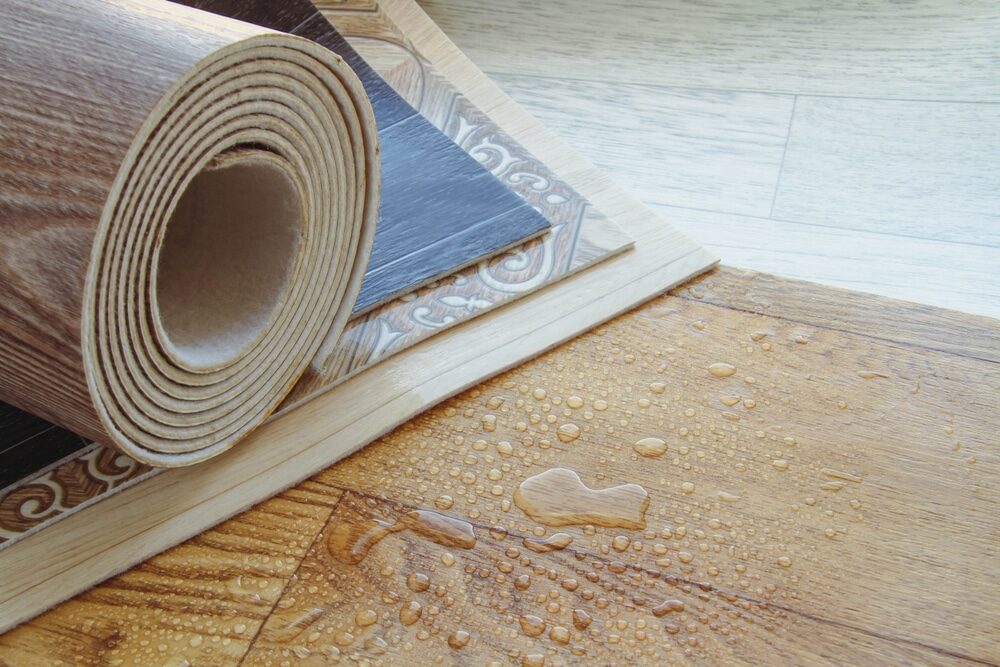
Disadvantages of Vinyl Flooring
- Susceptibility to Fading and Scratches: Although durable, vinyl can fade over time when exposed to direct sunlight and can get scratched by sharp objects.
- Environmental Impact: Vinyl is a synthetic material, and its production and disposal raise environmental concerns. It’s not as eco-friendly as some natural flooring options.
- Difficult to Repair: Vinyl flooring can be hard to repair if damaged. Often, the entire plank or tile needs to be replaced.
- Subfloor Sensitivity: Vinyl flooring requires a smooth and flawless subfloor; any imperfections can show through, especially over time.
- Potential for VOC Emissions: Some vinyl flooring can emit volatile organic compounds (VOCs), particularly when new, which can be a concern for indoor air quality.
- Limited Resale Value: Unlike hardwood or tile, vinyl flooring generally doesn’t add much to a home’s resale value.
- Not Always Suitable for Heavy Appliances: In some cases, heavy furniture or appliances can leave permanent dents in vinyl flooring.
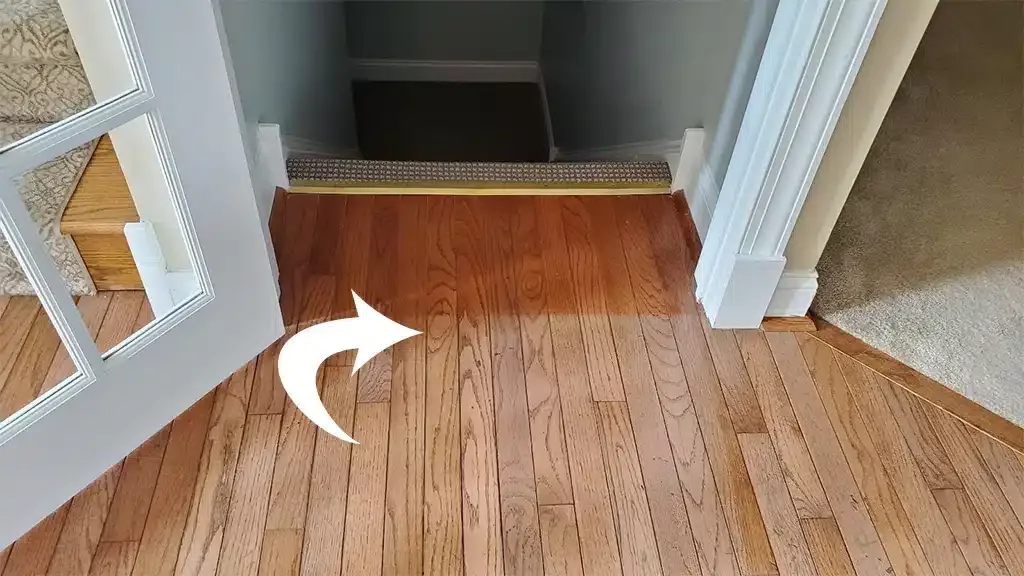
Understanding these pros and cons is crucial to making an informed decision that aligns with your specific needs, budget, and style preferences. Vinyl flooring offers a practical and versatile option, but it’s important to weigh these factors carefully to ensure it’s the right choice for your space.
Design and Aesthetic Options in Vinyl Flooring
Vinyl flooring in the UK offers an extensive array of design and aesthetic options, catering to diverse tastes and interior styles. This versatility is one of its key attractions. Here, we delve into the various design elements you can choose from when selecting vinyl flooring.
1. Patterns and Colours
- Wide Range of Patterns: From geometric patterns and abstract designs to natural looks, vinyl flooring offers an impressive range. You can find options that mimic stone, wood, and ceramic tiles.
- Colour Options: The colour choices are vast, ranging from classic neutrals to bold hues, allowing for complete personalisation of space.
2. Textures and Finishes
- Realistic Textures: Modern vinyl flooring can closely replicate the textures of natural materials like wood grain, stone, and ceramic.
- Variety of Finishes: Matte, glossy, and semi-gloss finishes are available, giving you the flexibility to match the flooring with the overall aesthetic of your room.
3. Customisation Possibilities
- Mix and Match: You can combine different tiles or planks to create unique patterns and designs, offering a custom look to your flooring.
- Borders and Accents: Use contrasting colours or patterns for borders or accents to add a distinctive touch to your floor design.
4. Plank and Tile Sizes
- Diverse Sizes and Shapes: Vinyl tiles and planks come in various sizes and shapes, allowing for creative layouts like herringbone, chevron, or staggered patterns.
5. 3D and Photorealistic Options
- Innovative 3D Designs: Some high-end vinyl products offer 3D and photorealistic designs that add depth and a sense of luxury to the flooring.
6. Integration with Interior Themes
- Versatility in Styling: Whether your interior theme is modern, rustic, industrial, or traditional, vinyl flooring can complement and enhance your decor style.
7. Specialised Designs
- Kid-Friendly and Themed Designs: Vinyl flooring also comes in fun, vibrant patterns suitable for children’s rooms or thematic designs for specific room concepts.
8. Eco-Friendly and Health-Conscious Options
- Sustainable Choices: For those conscious of environmental impact, there are vinyl options made from recycled materials with lower VOC emissions.
The aesthetic versatility of vinyl flooring means it can adapt to virtually any interior design need. From creating a cosy, traditional feel to setting a sleek, modern tone, vinyl flooring offers the flexibility to achieve your desired ambiance. This wide range of design options ensures that there’s a vinyl flooring choice for every taste and interior design scheme.
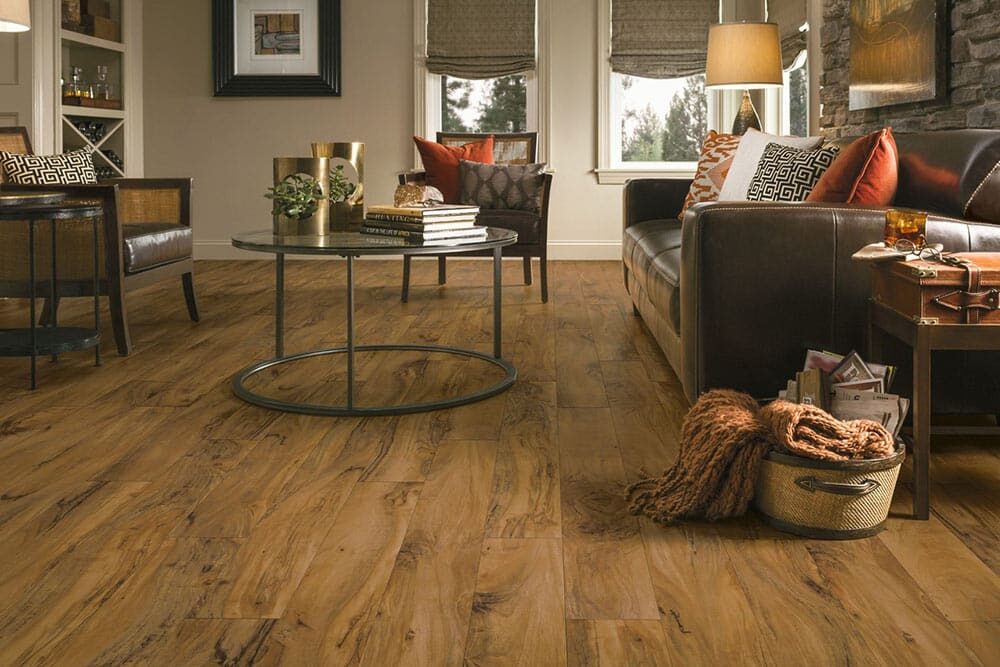
Installation and Maintenance of Vinyl Flooring
Vinyl flooring is renowned for its ease of installation and low maintenance requirements. Understanding the correct installation methods and maintenance practices is crucial to ensuring longevity and preserving the appearance of your vinyl flooring. Let’s explore these aspects in detail.
Installation of Vinyl Flooring
- Preparation of the Subfloor:
- The subfloor must be clean, dry, and level. Any imperfections can affect the final appearance and durability of the vinyl flooring.
- Moisture testing is recommended, especially for concrete subfloors.
- Types of Installation Methods:
- Glue-Down: Sheet vinyl and some tiles and planks require adhesive for installation. This method is more permanent and stable.
- Click-Lock: Many vinyl plank options come with a click-lock system, making them easy to install as a floating floor without adhesives.
- Peel-and-stick: Vinyl tiles often feature a peel-and-stick backing for an easy DIY installation.
- Professional vs. DIY Installation:
- While many vinyl flooring types are DIY-friendly, professional installation can ensure a flawless finish, especially for complex patterns or large areas.
- Tools and equipment:
- Basic tools like a utility knife, measuring tape, and a straightedge are usually sufficient for cutting and fitting vinyl flooring.
- Transition Strips and Edging:
- Proper installation includes transition strips at doorways or where the vinyl meets other flooring types, as well as edging to ensure a polished look.
Maintenance of Vinyl Flooring
- Regular Cleaning:
- Sweep or vacuum regularly to remove dirt and grit that can scratch the surface.
- Mop with a mild cleaner; avoid abrasive cleaners and excessive water.
- Spot Cleaning and Stain Removal:
- Wipe up spills promptly to prevent stains.
- Use specific cleaners recommended for vinyl flooring for tougher stains.
- Preventing Scratches and Damage:
- Use felt pads under furniture legs.
- Avoid dragging heavy objects across the floor.
- Consider using doormats to minimise the amount of dirt and grit tracked onto the floor.
- Long-Term Care:
- Occasionally, you might need to strip and reapply the finish on the vinyl to keep it looking new, especially in high-traffic areas.
- Avoid using wax-based cleaners and other products not designed for vinyl flooring, as they can dull its finish.
- Repairing Damages:
- Individual tiles or planks can be replaced if damaged. It’s a good idea to keep some extra pieces from the initial installation for this purpose.
By following these installation and maintenance guidelines, your vinyl flooring can remain attractive and durable for many years, making it an excellent investment for both homes and businesses.
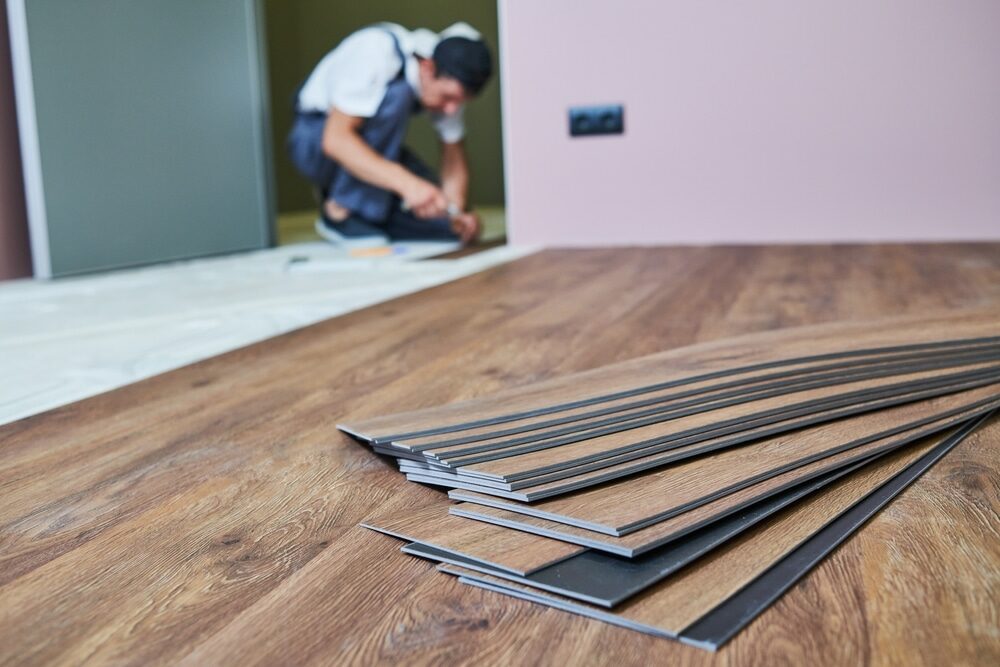
Cost Considerations for Vinyl Flooring
When considering vinyl flooring for your UK property, understanding the cost implications is crucial for effective budgeting and decision-making. Vinyl flooring, known for its affordability, still varies in price based on type, quality, and additional factors. Here’s a breakdown of the key cost considerations:
1. Types and Quality of Vinyl Flooring
- Sheet vinyl is generally the most affordable option, ideal for those on a tight budget.
- Vinyl Tiles and Planks: mid-range in terms of pricing, offering a balance between cost and a more upscale look.
- Luxury Vinyl Tiles (LVT): the higher-end option, typically more expensive due to their superior aesthetic and durability.
2. Pricing Variations
- Basic vs. Premium Ranges: Prices can vary significantly from basic, functional options to premium, designer ranges.
- Thickness and Wear Layer: Thicker vinyl with a more robust wear layer typically costs more but offers greater longevity.
3. Installation Costs
- DIY vs. Professional Installation: While DIY installation can save money, professional installation ensures quality but adds to the overall cost.
- Complexity of Installation: Custom patterns or layouts, like herringbone or intricate tile designs, can increase installation costs.
4. Subfloor Preparation
- Preparation Work: If the subfloor requires significant preparation, such as levelling or repairing, this can add to the cost.
- Underlayment: Some vinyl flooring types may require a specific underlayment, which is an additional expense.
5. Additional Materials
- Adhesives and Tools: Necessary for certain types of vinyl flooring, adding to the overall cost.
- Trim and Transitions: Items like baseboard trim, transition strips, and thresholds will be part of the budget.
6. Maintenance and longevity
- Maintenance Products: Regular cleaning and occasional deeper maintenance might require specific products.
- Replacement Costs: While vinyl is durable, replacement or repair costs should be considered in long-term budgeting.
7. Size of the Area
- Total Square Footage: Larger areas will require more material and potentially more complex installation, increasing the overall cost.
8. Geographic Location
- Regional Price Differences: Costs can vary based on location within the UK, due to differences in labour rates and material availability.
9. Brand and Retailer
- Brand Choice: Premium brands typically command higher prices.
- Retailer Options: Prices can vary between retailers; it’s advisable to shop around for the best deal.
Understanding these cost elements will help you create a realistic budget for your vinyl flooring project. Remember, while initial cost is an important consideration, factors like durability, maintenance, and aesthetic appeal should also play a role in your final decision.
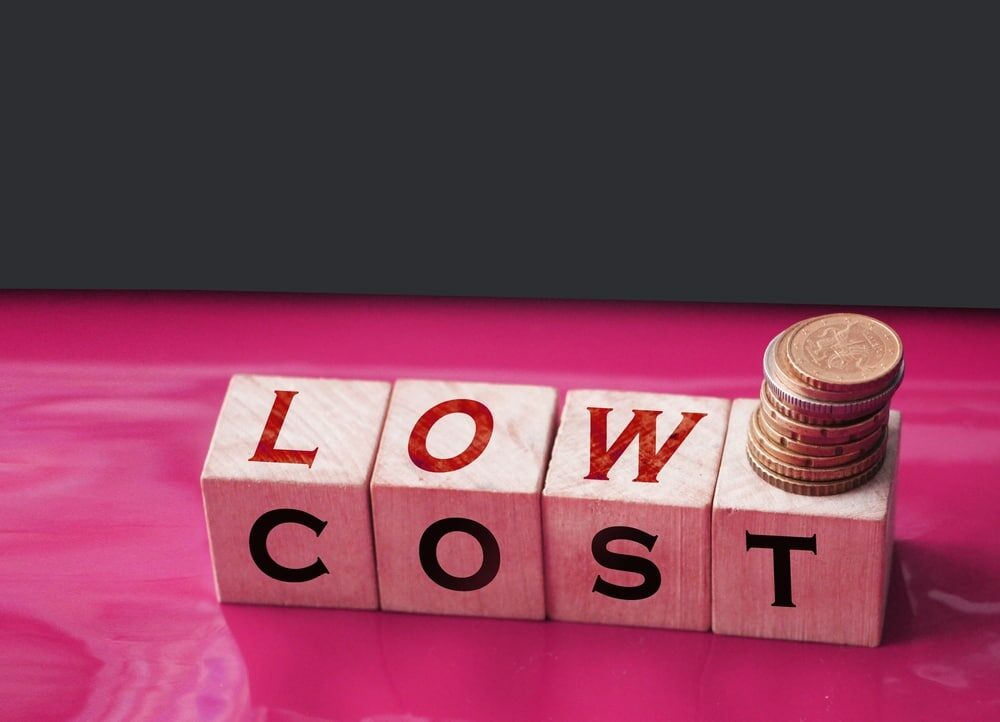
Environmental and health aspects of vinyl flooring
When selecting vinyl flooring, it’s important to consider its environmental impact and potential health implications. Being informed about these aspects will help you make a choice that aligns with your environmental concerns and health priorities.
Environmental Impact of Vinyl Flooring
- Manufacturing Process:
- Vinyl flooring is made from synthetic materials, primarily polyvinyl chloride (PVC). The production process can have environmental implications, including the use of non-renewable resources and the emission of greenhouse gases.
- Recyclability and Waste:
- Some types of vinyl flooring are recyclable, but not all. The recyclability depends on the composition and adhesive used.
- The disposal of vinyl flooring can contribute to landfill waste, as not all types are biodegradable.
- Sustainable Alternatives:
- There are eco-friendlier options available, like vinyl flooring made from recycled materials or those certified by environmental standards (e.g., FloorScore, GreenGuard).
- Some manufacturers are making strides in creating more sustainable vinyl products with lower environmental footprints.
Health Considerations for Vinyl Flooring
- Volatile Organic Compounds (VOCs):
- Some vinyl flooring can emit VOCs, especially when new. These emissions can affect indoor air quality and may cause health issues like headaches, eye irritation, or respiratory problems.
- It’s advisable to look for low-VOC or VOC-free vinyl flooring options.
- Phthalates and plasticizers:
- Certain types of vinyl flooring contain phthalates and other plasticizers, which have raised health concerns. Phthalates can be released into the air and have been linked to various health issues.
- Many manufacturers now offer phthalate-free vinyl flooring options.
- Allergies and hygiene:
- Vinyl flooring is resistant to dust mites, mould, and mildew, making it a good option for people with allergies.
- Its easy-to-clean surface helps maintain a hygienic environment, reducing the likelihood of indoor allergens.
Making an informed choice
- Certifications and Standards: Look for vinyl flooring that meets strict environmental and health standards, indicated by certifications like FloorScore or GreenGuard.
- Ventilation: Proper ventilation during and after installation can mitigate the effects of any VOC emissions.
- Research and Inquiries: Before purchasing, research the product’s environmental and health properties and inquire with manufacturers about their sustainability practices and material safety.
Considering the environmental and health aspects of vinyl flooring is crucial, especially for those with health sensitivities or a strong commitment to environmental sustainability.
Future trends and innovations in vinyl flooring
The vinyl flooring industry is continuously evolving, driven by technological advancements and changing consumer preferences. Here, we explore the emerging trends and innovations that are shaping the future of vinyl flooring, particularly in the UK market.
1. Eco-Friendly Developments
- Sustainable Materials: An increasing focus on sustainability is leading to the development of eco-friendlier vinyl flooring options, incorporating recycled materials, and reducing the use of harmful chemicals.
- Improved Recycling Processes: Innovations in recycling are expected to make vinyl flooring more sustainable, reducing its environmental footprint through better end-of-life management.
2. Advanced Printing and Texturing Technologies
- High-Definition Printing: With advancements in digital printing, future vinyl flooring is likely to offer even more realistic designs, closely mimicking natural materials like wood and stone.
- Enhanced Textures: Emerging technologies are enabling more sophisticated texturing of vinyl surfaces, enhancing the tactile experience and realism.
3. Health and Safety Enhancements
- Low-VOC and Non-Toxic Options: As health awareness increases, the demand for low-VOC and non-toxic vinyl flooring is expected to grow, ensuring better indoor air quality.
- Antimicrobial and Hygienic Surfaces: Innovations in surface treatments might lead to the widespread availability of vinyl flooring with antimicrobial properties, ideal for healthcare settings and homes.
4. Smart and Functional Flooring
- Integrated Technology: The future may see the integration of smart technology in flooring, such as embedded sensors for monitoring environmental conditions or for use in interactive spaces.
- Functional Flooring: There’s potential for development in multi-functional vinyl flooring, such as options that offer additional insulation, soundproofing, or even underfloor heating compatibility.
5. Style and Design Evolution
- Bolder Patterns and Colours: As consumer preferences evolve, expect to see more daring and vibrant designs, moving away from traditional looks to more contemporary and unique styles.
- Customisation and Personalisation: Advancements in manufacturing could allow for greater customisation options for consumers, enabling personalised designs and patterns.
6. Improved Durability and Performance
- Enhanced Wear Layers: Research and development are likely to lead to more robust wear layers, extending the lifespan of vinyl flooring and improving its resistance to scratches and dents.
- Climate-Adaptive Materials: Innovations may include materials that are better suited to various climates, ensuring the vinyl flooring performs optimally in different environmental conditions.
7. Market Expansion and Accessibility
- Increased Accessibility: As production methods improve, high-quality vinyl flooring might become more accessible and affordable for a broader range of consumers.
- Global Market Trends: The influence of global design trends will likely play a more significant role as consumers seek styles and materials popular in other parts of the world.
The future of vinyl flooring is exciting and promising, with trends and innovations focusing on sustainability, health, functionality, and design diversity. These advancements will not only enhance the aesthetic appeal of vinyl flooring but also its environmental compatibility and role in creating healthy living spaces.
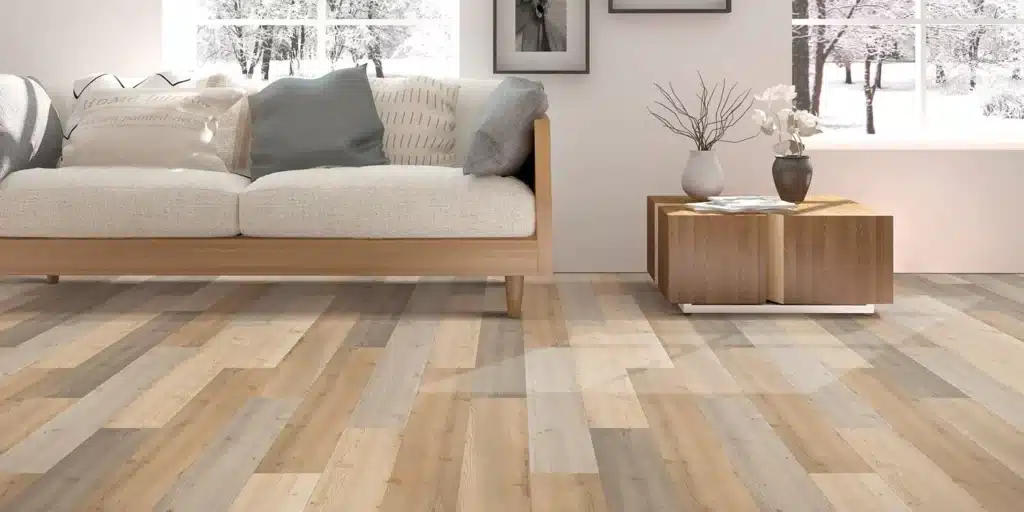
Conclusion: Navigating the World of Vinyl Flooring in the UK
As we conclude our comprehensive guide on vinyl flooring options in the UK, it’s clear that this versatile flooring solution offers a blend of style, functionality, and affordability. Whether for residential or commercial use, vinyl flooring presents an array of choices to suit diverse needs and preferences.
Key Takeaways
- Diverse Types and Styles: From budget-friendly sheet vinyl to luxurious LVT, there’s a vinyl flooring type for every space and style.
- Practical Benefits: Its durability, water resistance, and ease of maintenance make vinyl flooring a practical choice for various settings.
- Design Flexibility: With an extensive range of patterns, textures, and colours, vinyl flooring can complement any interior design scheme.
- Economic and Environmental Considerations: Vinyl offers cost-effective options, but it’s also important to consider its environmental and health impacts.
- Future-Forward: The industry is leaning towards more sustainable, technologically advanced, and diverse design options.
Final Recommendations
When choosing vinyl flooring in the UK, consider your specific needs: the room’s function, your aesthetic preferences, budget constraints, and environmental concerns. Also, ponder the long-term implications, like maintenance and durability.
Remember that while the initial cost is a factor, the longevity and quality of the flooring should also play a significant role in your decision-making process. Moreover, as the industry evolves, keep an eye out for new trends and innovations that might offer added benefits or align more closely with your values and style preferences.
Vinyl flooring stands out as a versatile, adaptable, and stylish option, capable of meeting the demands of modern homes and businesses. By carefully considering your options and staying informed about the latest developments, you can make a choice that not only looks great but also serves you well over time.

Sanding
We provide virtually dust-free sanding with our continuous belt machinery with mobile extraction units, giving you a safer environment for your family.
Oiling
This organic finish not only adds beauty to your home but also has exceptional water-repellent characteristics, making it easier to clean and maintain.
Waxing
This natural floor finish offers the softest and most mellow appearance – and leaves your floor able to breath.
Buffing
Using soft buffing machines (and hand-polishing where required) will bring a wonderful sheen to your newly-finished floor.
Repairs
We offer a full assessment of your wooden floors to determine what repairs are needed to provide the perfect working surface for the later stages of sanding, staining and sealing.
Restoration
We offer a comprehensive restoration process designed to address floors that are improperly fitted or damaged over time through wear and tear.
Request a fixed price quote for your wood floor restoration now
Simply enter your postcode below to get started.
Services
Wood Floor Sanding Wood Floor Restoration Wood Floor Scratch Repair Squeaky Wood Floor Repair Parquet Floor Sanding Parquet Floor Restoration Commercial Floor Sanding Church Floor Sanding Community Centre Floor Sanding School Floor Sanding Gap Filling Gap Filling with ResinCopyright © Mr Sander®
Privacy & Cookies Terms & Conditions Complaints Procedure Cancellation Rights Sitemap